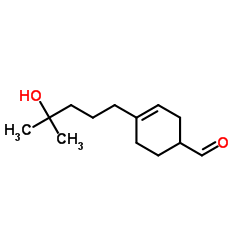Hydroxyisohexyl 3-cyclohexene carboxaldehyde (Lyral®) as allergen: experience from a contact dermatitis unit.
Rodrigo Carvalho, Paula Maio, Cristina Amaro, Raquel Santos, Jorge Cardoso
Index: Cutan. Ocul. Toxicol. 30(3) , 249-50, (2011)
Full Text: HTML
Abstract
Hydroxyisohexyl 3-cyclohexene carboxaldehyde (HICC)-Lyral® is a widely used synthetic fragrance found in personal care and household products. It is an aldehyde, lipophilic enough to penetrate the skin and is a frequent cause of contact sensitization.Describe the frequency of contact allergy to HICC in a Contact Dermatitis Unit, after its inclusion in baseline patch test series.A retrospective study including all patients submitted to patch test, from January 2007 to December 2009.Over a 3-year period, 629 consecutive patients were patch tested. The frequency of positive reactions to HICC was 2.7% (17/629). Of the positive patients, 35% (6/17) gave a history of atopy, 58.8% (10/17) had eczema on the face and neck, 23.5% (4/17) on the hands, 23.5% (4/17) in the axillae, 17.6% (3/17) on the trunk and 6% (3/17) had generalized eczema. All patients were patch positive for more than one allergen: all (17/17) positive to fragrance Mix 2 (FM2); 47% of the patients (8/17) positive to fragrance Mix 1 (FM1); and 23.5% of the patients (4/17) positive to Balsam of Peru. In 94% (16/17) of cases, the reaction was judged to be of current relevance.The frequency of positive reactions to HICC of 2.7% found in our population is according to what is described in several European reports, where HICC is still widely used as a fragrance ingredient. In contrast, in North America, the prevalence is lower. All the patients were positive also to FM2. The association found between reactions to FM1 and HICC is also commonly reported and could represent a concomitant sensitization following increased exposure to fragrance allergens. These data confirm the importance of HICC introduction in the baseline patch test series.
Related Compounds
| Structure | Name/CAS No. | Molecular Formula | Articles |
|---|---|---|---|
 |
4-(4-Hydroxy-4-methylpentyl)cyclohex-3-enecarbaldehyde
CAS:31906-04-4 |
C13H22O2 |
|
Enhanced sensitization and elicitation responses caused by m...
2011-12-01 [Contact Dermatitis 65(6) , 336-42, (2011)] |
|
Can exposure limitations for well-known contact allergens be...
2011-06-01 [Contact Dermatitis 64(6) , 337-42, (2011)] |
|
Experimental elicitation with hydroxyisohexyl-3-cyclohexene ...
2007-03-01 [Contact Dermatitis 56(3) , 146-50, (2007)] |
|
[Current contact allergens].
2011-10-01 [Hautarzt 62(10) , 751-6, (2011)] |
|
Two fragrance chemicals may act as toxicants via TRPA1 stimu...
2013-09-01 [Toxicol. In Vitro 27(6) , 2022, (2013)] |